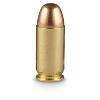I would like to discuss my findings and also some hypothesis. I hope I am right, if I say that .45 ACP is maybe the most favourite pistol caliber for disciplines where accuracy really matters. Let's put aside .32 SW because it's different league in accuracy due to fixed barrel. I wondered why people swear by .45 so often in terms of accuracy, whether it's due to popularity of 1911 platform or the cartridge. I am in a process of upgrading my press, mainly the powder measure system. It's no surprise that some powders meter better than others. I have measured two different powders which I use for reloading 9x19 and one meters with precision +-0.03 gr and the other one with precison +-0.015 gr (AA2). It is logical that everyone who is interested in achieving top accuracy from his pistol will be using the powder which meters with lower SD and max spread. However even the great powders like N310, W231, AA2 meters with deviations.
I compared some popular loads for .45 ACP with .40 and 9mm load with same deviation to see the pressure differences with same powder measure deviation.
For example .45 Nosler 185 JHP, OAL 1.200, 4,1 gr N310 in 4" barrel - pressure 15405 vs 15800 with 4,16 gr - 8 fps difference. In .40 the same deviation of only +-0.015 gr and the difference in pressure is 495 psi and 9 fps. In 9x19 it si 848 psi and 10 fps. Deviation of 0.015 gr is very small. I suppose that many reloaders get +-0.05 gr. With this deviation it is 649 psi (.45) vs. 829 psi (.40) vs. 1421 psi (9mm). And the same thing goes with the OAL - 0.01" change changes pressure for 436 psi (.45) vs. 497 psi (.40) vs. 912 psi (9mm).
These deviations in bullet seating and powder measuring can be limited but not eliminated. The absolute pressure difference will be always bigger in smaller cartridge. How important is this in terms of accuracy? When we consider the shape of the bullet, the 9 mm is much better than the .40 or .45. At least in terms of Miller twist rate rule. The ratio between the length and diameter of the bullet will be always better in 9 mm bullets.
Let's have 1911 with 3 different barrels, all fitted properly by gunsmith. Which caliber has the biggest potential when the accuracy is all that matters (we don't mind low power factor nor the gun recoil of kicking horse)?
I compared some popular loads for .45 ACP with .40 and 9mm load with same deviation to see the pressure differences with same powder measure deviation.
For example .45 Nosler 185 JHP, OAL 1.200, 4,1 gr N310 in 4" barrel - pressure 15405 vs 15800 with 4,16 gr - 8 fps difference. In .40 the same deviation of only +-0.015 gr and the difference in pressure is 495 psi and 9 fps. In 9x19 it si 848 psi and 10 fps. Deviation of 0.015 gr is very small. I suppose that many reloaders get +-0.05 gr. With this deviation it is 649 psi (.45) vs. 829 psi (.40) vs. 1421 psi (9mm). And the same thing goes with the OAL - 0.01" change changes pressure for 436 psi (.45) vs. 497 psi (.40) vs. 912 psi (9mm).
These deviations in bullet seating and powder measuring can be limited but not eliminated. The absolute pressure difference will be always bigger in smaller cartridge. How important is this in terms of accuracy? When we consider the shape of the bullet, the 9 mm is much better than the .40 or .45. At least in terms of Miller twist rate rule. The ratio between the length and diameter of the bullet will be always better in 9 mm bullets.
Let's have 1911 with 3 different barrels, all fitted properly by gunsmith. Which caliber has the biggest potential when the accuracy is all that matters (we don't mind low power factor nor the gun recoil of kicking horse)?


